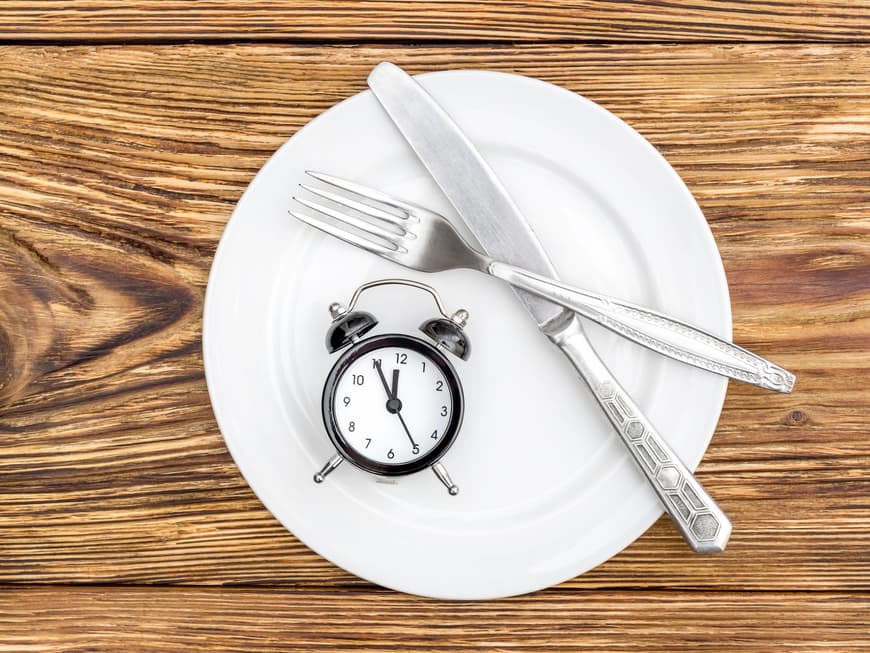
What are the benefits of intermittent fasting?
The fact is that the majority of people eat too much. Breakfast in the morning, lunch at noon and an extended dinner in the evening. Snacks in between, which are usually quite high in calories. It has been proven that this is not healthy in the long term and makes you fat. Intermittent fasting promises to be a new star in the weight loss firmament, as this enjoyable reduction is not primarily about giving up food. Can it really work? Yes, because it has been proven to improve sugar and fat metabolism. This is generally desirable and helps to keep the body healthy. According to nutrition expert Dr. Matthias Riedl, intermittent fasting is therefore generally very suitable as a form of nutrition. The positive effect when losing weight: The entire metabolism is not completely throttled as with dieting - so no muscle mass is broken down and the so-called yo-yo effect, which many diets entail, is prevented. The great thing is that both fasting methods can be easily incorporated into everyday life, so that not every meal invitation turns into a nightmare. Read on to find out exactly how intermittent fasting works.
Intermittent fasting: how it works
The idea behind the weight loss concept of intermittent fasting is clear from the name. It involves fasting at intervals, i.e. intermittently. At the beginning, there should be five hours between meals. This is how you maintain your weight. If you want to reduce your weight, the breaks between meals can be increased up to 16 hours during the night. You can also incorporate entire fasting days. With the so-called 5:2 method, you would eat normally five days a week and then completely abstain from solid food for two days.
Daily routine during intermittent fasting: 8:16 method
The 8:16 method of intermittent fasting involves going without food for 16 hours at a time. In other words, you go without one meal a day. This is what your day could look like using this method: For breakfast at 9 am, you have muesli, fruit or wholemeal bread with cucumber and radishes. At 5 pm you eat your evening meal and the last meal of the day. The next day at 9 a.m. you continue with breakfast. You eat normally at all meals, i.e. no more or less than usual.
Intermittent fasting using the 5:2 method
If you find the breaks between meals too long with the 8:16 method or generally can't cope with just two meals a day, try the 5:2 method. You eat normally on 5 days a week and fast on two non-consecutive days. You determine the fasting days yourself. Eating normally in this case also means no less, but also no more than usual. On the fasting days you eat a maximum of 500 calories, including all drinks. Distribute the calories over one to three meals as required. It makes sense to choose foods with the lowest possible calorie content, e.g. water, tea, broth, salad, vegetables and fish.
Who can do intermittent fasting?
People who suffer from the following pre-existing conditions are not suitable for intermittent fasting:
- Metabolic diseases
- low blood pressure
- cancer
- Eating disorders such as anorexia or bulimia
- Pregnancy and breastfeeding
- In the case of chronic illnesses, it is better to consult a doctor beforehand
6 golden rules for intermittent fasting
1. organization is everything: plan exactly what you are going to eat and when on the fasting day. This way you won't jeopardize the success of the whole day in a single weak moment.
2. value quality: You eat little, so what goes on your plate should be high quality and varied.
3. individual: try out which meal times are best for you. A late lunch? Three mini-meals? Whatever is easiest for you is the way to go.
4. save oil: There's no room for fat calories on 5:2 fast days. Steaming, steaming and baking save calories.
5. wow ingredients: Turn your fasting days into indulgence days and treat yourself to delicious luxury ingredients: Prawns, strawberries, fillet. Fresh herbs refine dishes. Every calorie must be worth eating.
6. know your calories: Read package information and get a feel for the energy content of foods. This will help you keep track.
